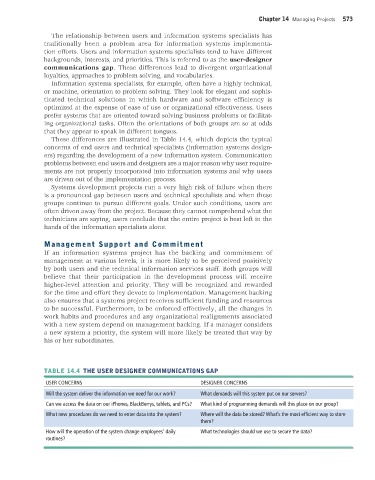Page 574 -
P. 574
Chapter 14 Managing Projects 573
The relationship between users and information systems specialists has
traditionally been a problem area for information systems implementa-
tion efforts. Users and information systems specialists tend to have different
backgrounds, interests, and priorities. This is referred to as the user-designer
communications gap. These differences lead to divergent organizational
loyalties, approaches to problem solving, and vocabularies.
Information systems specialists, for example, often have a highly technical,
or machine, orientation to problem solving. They look for elegant and sophis-
ticated technical solutions in which hardware and software efficiency is
optimized at the expense of ease of use or organizational effectiveness. Users
prefer systems that are oriented toward solving business problems or facilitat-
ing organizational tasks. Often the orientations of both groups are so at odds
that they appear to speak in different tongues.
These differences are illustrated in Table 14.4, which depicts the typical
concerns of end users and technical specialists (information systems design-
ers) regarding the development of a new information system. Communication
problems between end users and designers are a major reason why user require-
ments are not properly incorporated into information systems and why users
are driven out of the implementation process.
Systems development projects run a very high risk of failure when there
is a pronounced gap between users and technical specialists and when these
groups continue to pursue different goals. Under such conditions, users are
often driven away from the project. Because they cannot comprehend what the
technicians are saying, users conclude that the entire project is best left in the
hands of the information specialists alone.
Management Support and Commitment
If an information systems project has the backing and commitment of
management at various levels, it is more likely to be perceived positively
by both users and the technical information services staff. Both groups will
believe that their participation in the development process will receive
higher-level attention and priority. They will be recognized and rewarded
for the time and effort they devote to implementation. Management backing
also ensures that a systems project receives sufficient funding and resources
to be successful. Furthermore, to be enforced effectively, all the changes in
work habits and procedures and any organizational realignments associated
with a new system depend on management backing. If a manager considers
a new system a priority, the system will more likely be treated that way by
his or her subordinates.
TABLE 14.4 THE USER DESIGNER COMMUNICATIONS GAP
USER CONCERNS DESIGNER CONCERNS
Will the system deliver the information we need for our work? What demands will this system put on our servers?
Can we access the data on our iPhones, BlackBerrys, tablets, and PCs? What kind of programming demands will this place on our group?
What new procedures do we need to enter data into the system? Where will the data be stored? What’s the most efficient way to store
them?
How will the operation of the system change employees’ daily What technologies should we use to secure the data?
routines?
MIS_13_Ch_14_global.indd 573 1/17/2013 2:31:59 PM

